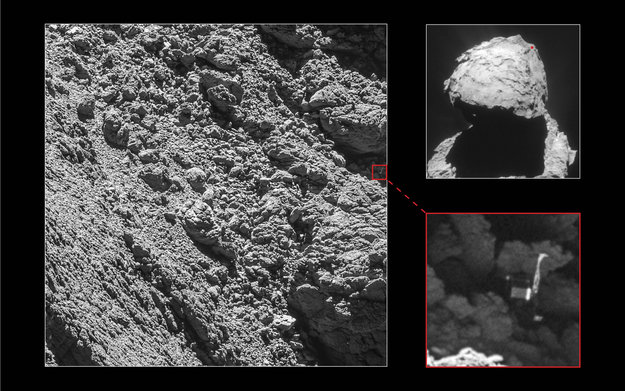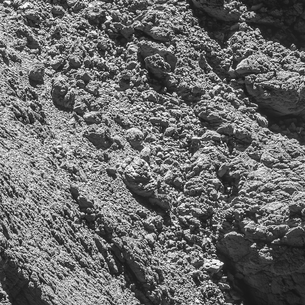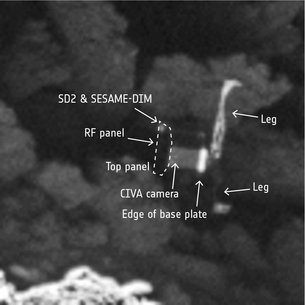A menos de un mes antes del final de la misión, cámara de alta resolución de Rosetta ha revelado el aterrizador(Robot)Philae, está encajada en una grieta oscura, en el cometa 67P / Churyumov-Gerasimenko.
Las imágenes fueron tomadas el 2 de septiembre por la cámara de ángulo estrecho de Osiris como el orbitador se quedó a 2,7 km de la superficie y muestran claramente el cuerpo principal del módulo de aterrizaje, junto con dos de sus tres patas.
Las imágenes también proporcionan una prueba de orientación de Philae, por lo que es claro por qué el establecimiento de comunicaciones era tan difícil después de su aterrizaje el 12 de noviembre de 2014.
Las imágenes fueron tomadas el 2 de septiembre por la cámara de ángulo estrecho de Osiris como el orbitador se quedó a 2,7 km de la superficie y muestran claramente el cuerpo principal del módulo de aterrizaje, junto con dos de sus tres patas.
Las imágenes también proporcionan una prueba de orientación de Philae, por lo que es claro por qué el establecimiento de comunicaciones era tan difícil después de su aterrizaje el 12 de noviembre de 2014.
(CNN) - Se creía que Philae, el pequeño robot espacial que cautivó corazones alrededor del mundo, se había perdido para siempre.
Pero científicos anunciaron encantados el domingo que el módulo de la Agencia Espacial Europea está de regreso de entre los muertos cósmicos.
Nuevas imágenes descargadas de la sonda Rosetta en órbita alrededor del cometa 67P/Churyumov-Gerasimenko muestran al robot Philae en medio de unas rocas. Rosetta tomó las imágenes just a tiempo, porque su misión termina en menos de un mes.
Philae found!
5 September 2016
Less than a month before the end of the mission, Rosetta’s high-resolution camera has revealed the Philae lander wedged into a dark crack on Comet 67P/Churyumov–Gerasimenko.
The images were taken on 2 September by the OSIRIS narrow-angle camera as the orbiter came within 2.7 km of the surface and clearly show the main body of the lander, along with two of its three legs.
The images also provide proof of Philae’s orientation, making it clear why establishing communications was so difficult following its landing on 12 November 2014.
“With only a month left of the Rosetta mission, we are so happy to have finally imaged Philae, and to see it in such amazing detail,” says Cecilia Tubiana of the OSIRIS camera team, the first person to see the images when they were downlinked from Rosetta yesterday.
“After months of work, with the focus and the evidence pointing more and more to this lander candidate, I’m very excited and thrilled that we finally have this all-important picture of Philae sitting in Abydos,” says ESA’s Laurence O’Rourke, who has been coordinating the search efforts over the last months at ESA, with the OSIRIS and Lander Science Operations and Navigation Center (SONC, CNES) teams.
Philae was last seen when it first touched down at Agilkia, bounced and then flew for another two hours before ending up at a location later named Abydos, on the comet’s smaller lobe.
After three days, Philae's primary battery was exhausted and the lander went into hibernation, only to wake up again and communicate briefly with Rosetta in June and July 2015 as the comet came closer to the Sun and more power was available.
However, until today, the precise location was not known. Radio ranging data tied its location down to an area spanning a few tens of metres, but a number of potential candidate objects identified in relatively low-resolution images taken from larger distances could not be analysed in detail until recently.
While most candidates could be discarded from analysis of the imagery and other techniques, evidence continued to build towards one particular target, which is now confirmed in images taken unprecedentedly close to the surface of the comet.
At 2.7 km, the resolution of the OSIRIS narrow-angle camera is about 5 cm/pixel, sufficient to reveal characteristic features of Philae’s 1 m-sized body and its legs, as seen in these definitive pictures.
“This remarkable discovery comes at the end of a long, painstaking search,” says Patrick Martin, ESA’s Rosetta Mission Manager. “We were beginning to think that Philae would remain lost forever. It is incredible we have captured this at the final hour.”
“This wonderful news means that we now have the missing ‘ground-truth’ information needed to put Philae’s three days of science into proper context, now that we know where that ground actually is!” says Matt Taylor, ESA’s Rosetta project scientist.
"Now that the lander search is finished we feel ready for Rosetta's landing, and look forward to capturing even closer images of Rosetta's touchdown site,” adds Holger Sierks, principal investigator of the OSIRIS camera.
The discovery comes less than a month before Rosetta descends to the comet’s surface. On 30 September, the orbiter will be sent on a final one-way mission to investigate the comet from close up, including the open pits in the Ma’at region, where it is hoped that critical observations will help to reveal secrets of the body’s interior structure.
Further information on the search that led to the discovery of Philae, along with additional images, will be made available soon.
Continue
For further information, please contact: Markus Bauer
ESA Science and Robotic Exploration Communication Officer
Tel: +31 71 565 6799
Mob: +31 61 594 3 954
Email: markus.bauer@esa.int
Laurence O’Rourke
ESA lander search coordinator
Email: lorourke@esa.int
Cecilia Tubiana
OSIRIS imaging team
Max Planck Institute for Solar System Research
Email: tubiana@mps.mpg.de
Holger Sierks
OSIRIS camera principal investigator
Max Planck Institute for Solar System Research
Email: sierks@mps.mpg.de
Matt Taylor
ESA Rosetta project scientist
Email: matthew.taylor@esa.int
Patrick Martin
ESA Rosetta mission manager
Email: Patrick.martin@esa.int
VERSIÓN EN ESPAÑOL :
ESA Science and Robotic Exploration Communication Officer
Tel: +31 71 565 6799
Mob: +31 61 594 3 954
Email: markus.bauer@esa.int
Laurence O’Rourke
ESA lander search coordinator
Email: lorourke@esa.int
Cecilia Tubiana
OSIRIS imaging team
Max Planck Institute for Solar System Research
Email: tubiana@mps.mpg.de
Holger Sierks
OSIRIS camera principal investigator
Max Planck Institute for Solar System Research
Email: sierks@mps.mpg.de
Matt Taylor
ESA Rosetta project scientist
Email: matthew.taylor@esa.int
Patrick Martin
ESA Rosetta mission manager
Email: Patrick.martin@esa.int
VERSIÓN EN ESPAÑOL :
¡PHILAE HA APARECIDO!
5 septiembre 2016
A menos de un mes de finalizar su misión, la cámara de alta resolución de Rosetta ha descubierto el módulo de aterrizaje Philae, encajado en una oscura grieta de 67P/Churyumov–Gerasimenko.
Las imágenes fueron captadas por el teleobjetivo de la cámara OSIRIS el 2 de septiembre, cuando el satélite se encontraba a 2,7 km de la superficie del cometa, y muestran claramente el cuerpo principal del módulo y dos de sus tres patas.
Las imágenes también muestran la orientación de Philae, lo que explica por qué resultó tan difícil comunicarse con él tras su aterrizaje el 12 de noviembre de 2014.
“Cuando solo queda un mes de la misión Rosetta, estamos encantados de haber localizado a Philae y de poder verlo con tanto detalle”, reconoce Cecilia Tubiana, del equipo de la cámara OSIRIS, la primera persona en ver las imágenes transmitidas ayer por Rosetta.
Laurence O’Rourke, encargado de coordinar en la ESA los trabajos de búsqueda con los equipos de OSIRIS y SONC/CNES a lo largo de los últimos meses, añade: “Tras meses de trabajo, todo apuntaba cada vez más a este candidato, por lo que me alegro enormemente de que por fin hayamos conseguido esta importantísima imagen de Philae en Abydos”.
El módulo Philae fue visto por última vez al tocar la superficie de la zona conocida como Agilkia, donde rebotó y continuó volando otras dos horas, antes de acabar en un lugar denominado posteriormente Abydos, en el lóbulo inferior del cometa.
Al cabo de tres días, la batería principal de Philae se agotó y el módulo de aterrizaje pasó al estado de hibernación, del que volvió a salir para comunicarse brevemente con Rosetta en junio y julio de 2015, cuando el comenta se acercó al sol y la batería volvió a recibir alimentación.
No obstante, hasta hoy se desconocía la ubicación precisa del módulo. Aunque los datos de alcance de radio limitaban la ubicación a un área de pocas decenas de metros de diámetro, no se habían podido analizar al detalle los distintos objetos identificados como candidatos potenciales en imágenes de una resolución relativamente baja, captadas a mayor distancia.
A medida que la mayoría de candidatos se iban descartando una vez analizadas las imágenes o aplicando otras técnicas, las pruebas apuntaban cada vez más hacia un objeto en particular, que es el que ha terminado por confirmarse gracias a las imágenes tomadas a muy poca distancia de la superficie del cometa.
A 2,7 km, la resolución del teleobjetivo de la cámara OSIRIS es de unos 5 cm/píxel, suficiente para mostrar las características del cuerpo de Philae, de 1 m de diámetro, y sus patas, tal y como puede apreciarse en las fotografías.
Como reconoce Patrick Martin, responsable de la misión Rosetta de la ESA: “Este notable descubrimiento es el resultado de unos trabajos de búsqueda prolongados y meticulosos. Empezábamos a pensar que habíamos perdido a Philae para siempre. Es increíble que hayamos conseguido capturar estas imágenes en el último momento”.
Matt Taylor, científico del proyecto Rosetta de la ESA, añade: “Esta fantástica noticia implica que, ahora que sabemos dónde se encuentra el punto de aterrizaje, finalmente contamos con la información fidedigna que nos faltaba para poner en contexto los tres días de datos científicos de Philae”.
“Con la búsqueda del módulo finalizada, podemos centrarnos en el aterrizaje de Rosetta y ya estamos deseando obtener imágenes aún más precisas del lugar del impacto”, admite Holger Sierks, investigador principal de la cámara OSIRIS.
El descubrimiento llega a menos de un mes del descenso de Rosetta a la superficie de 67P/Churyumov–Gerasimenko. El 30 de septiembre, la sonda iniciará su misión final en un viaje sin retorno para investigar de cerca el cometa, incluyendo las fosas de la región de Ma’at. Se espera que las observaciones que realice contribuirán a desvelar los secretos de su estructura interior.
Pronto se publicará más información sobre los trabajos de búsqueda que han concluido con el descubrimiento de Philae, así como nuevas imágenes.
Para más información:
Markus Bauer
ESA Science and Robotic Exploration Communication Officer
Tel: +31 71 565 6799
Móvil: +31 61 594 3 954
Correo electrónico: markus.bauer@esa.int
ESA Science and Robotic Exploration Communication Officer
Tel: +31 71 565 6799
Móvil: +31 61 594 3 954
Correo electrónico: markus.bauer@esa.int
Laurence O’Rourke
ESA lander search coordinator
Correo electrónico: lorourke@esa.int
ESA lander search coordinator
Correo electrónico: lorourke@esa.int
Cecilia Tubiana
OSIRIS imaging team
Max Planck Institute for Solar System Research
Correo electrónico: tubiana@mps.mpg.de
OSIRIS imaging team
Max Planck Institute for Solar System Research
Correo electrónico: tubiana@mps.mpg.de
Holger Sierks
OSIRIS camera principal investigator
Max Planck Institute for Solar System Research
Correo electrónico: sierks@mps.mpg.de
OSIRIS camera principal investigator
Max Planck Institute for Solar System Research
Correo electrónico: sierks@mps.mpg.de
Matt Taylor
ESA Rosetta project scientist
Correo electrónico: matthew.taylor@esa.int
ESA Rosetta project scientist
Correo electrónico: matthew.taylor@esa.int
Patrick Martin
ESA Rosetta mission manager
Correo electrónico: Patrick.martin@esa.int
ESA Rosetta mission manager
Correo electrónico: Patrick.martin@esa.int
Para más información:
Markus Bauer
ESA Science and Robotic Exploration Communication Officer
Tel: +31 71 565 6799
Móvil: +31 61 594 3 954
Correo electrónico: markus.bauer@esa.int
ESA Science and Robotic Exploration Communication Officer
Tel: +31 71 565 6799
Móvil: +31 61 594 3 954
Correo electrónico: markus.bauer@esa.int
Laurence O’Rourke
ESA lander search coordinator
Correo electrónico: lorourke@esa.int
ESA lander search coordinator
Correo electrónico: lorourke@esa.int
Cecilia Tubiana
OSIRIS imaging team
Max Planck Institute for Solar System Research
Correo electrónico: tubiana@mps.mpg.de
OSIRIS imaging team
Max Planck Institute for Solar System Research
Correo electrónico: tubiana@mps.mpg.de
Holger Sierks
OSIRIS camera principal investigator
Max Planck Institute for Solar System Research
Correo electrónico: sierks@mps.mpg.de
OSIRIS camera principal investigator
Max Planck Institute for Solar System Research
Correo electrónico: sierks@mps.mpg.de
Matt Taylor
ESA Rosetta project scientist
Correo electrónico: matthew.taylor@esa.int
ESA Rosetta project scientist
Correo electrónico: matthew.taylor@esa.int
Patrick Martin
ESA Rosetta mission manager
Correo electrónico: Patrick.martin@esa.int
ESA Rosetta mission manager
Correo electrónico: Patrick.martin@esa.int
Guillermo Gonzalo Sánchez Achutegui
ayabaca@gmail.com
ayabaca@hotmail.com
ayabaca@yahoo.com
Inscríbete en el Foro del blog y participa : A Vuelo De Un Quinde - El Foro!





No hay comentarios:
Publicar un comentario